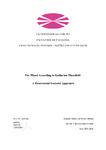The Māori According to Katherine Mansfield: A Postcolonial Feminist Approach

Use este enlace para citar
http://hdl.handle.net/2183/41063Coleccións
Metadatos
Mostrar o rexistro completo do ítemTítulo
The Māori According to Katherine Mansfield: A Postcolonial Feminist ApproachAutor(es)
Director(es)
Núñez-Puente, CarolinaData
2024Centro/Dpto/Entidade
Universidade da Coruña. Facultade de FiloloxíaDescrición
Traballo fin de grao (UDC.FIL). Inglés: estudios lingüísticos y literarios. Curso 2023/2024Resumo
[]Abstract] This undergraduate dissertation explores Katherine Mansfield’s representations of
Māori people in her early texts, written between 1907 and 1915, through a postcolonial
feminist approach. For this purpose, I analyze three short stories—“How Pearl Button Was
Kidnapped” (1912), “Summer Idyll” (1907), and “Young Country” (1913)—with special
attention to ethnic difference, gender relations, and cultural identity; additionally, I explore
the relationship between colonizer and colonized women through her portrayal of both the
white settlers and the Māori in the social context of colonial New Zealand.
As for the methodology, I rely on Gerri Kimber and Vincent O’Sullivan’s The
Collected Fiction of Katherine Mansfield, 1898-1915 for texts that strongly feature Māori
characters. For an introductory approach to postcolonial feminism, I refer to the work of
Chandra Talpade Mohanty, Gayatri Spivak, and Deepika Bahri. In addition, I examine the
available critical literature on Mansfield’s early writings, particularly Janet Wilson’s
postcolonial readings. Then, I consider in detail the three texts selected, through a close reading analysis that takes their context into account. Lastly, I refer to historical sources such
as George Grey’s Polynesian Mythology and Ancient Traditional History of the New Zealand
Race and dictionaries like Patrick Hanks and Flavia Hodges’ A Dictionary of First Names,
which contextualize some of Mansfield’s literary devices.
This paper consists of two main parts: the first part provides a definition of
postcolonial feminism, its object of study and key concepts, which are used as the framework
for the literary analysis; the second part begins by exploring different critical approaches to
Mansfield’s work and its postcolonial elements. This section is also divided in three
subsections, each of which is dedicated to the analysis of a short story’s subject matter and
stylistic features.
The three texts studied portray a complex relationship between a female settler and
one or more Māori women. The relationships differ in nature and fluctuate between
fascination, fear, and attraction; moreover, the settler usually finds in her Māori counterpart
an alternative to the western values that have been imposed upon her. Through a postcolonial
feminist reading, I conclude that Māori women are central to Mansfield’s production during
her early years as a writer though these representations are ambivalent and complex. While
Māori culture often appears as liberating and attractive, this portrayal also results in
essentialist tropes, exoticism, and the ambivalence that is common in colonizer literature;
nevertheless, Mansfield experiments with binaries of gender, ethnicity, and culture, which
produces a multilayered representation of the intersections between settler and indigenous
women in the colonial setting
Palabras chave
Katherine Mansfield
Māori
Post-colonialism
Feminism
Representation
Māori
Post-colonialism
Feminism
Representation
Dereitos
Os titulares dos dereitos de propiedade intelectual autorizan a visualización do contido deste traballo a través de Internet, así como a súa reproducción, gravación en soporte informático ou impresión para o seu uso privado e/ou con fins de estudo e de investigación. En nengún caso se permite o uso lucrativo deste documento. Estos dereitos afectan tanto ao resumo do traballo como ao seu contido. Los titulares de los derechos de propiedad intelectual autorizan la visualización del contenido de este trabajo a través de Internet, así como su reproducción, grabación en soporte informático o impresión para su uso privado y/o con fines de estudio e investigación. En ningún caso se permite el uso lucrativo de este documento. Estos derechos afectan tanto al resumen del trabajo como a su contenido.





